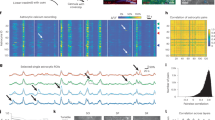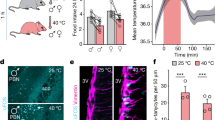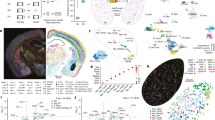Abstract
Major depression is characterized by diverse debilitating symptoms that include hopelessness and anhedonia1. Dopamine neurons involved in reward and motivation2,3,4,5,6,7,8,9 are among many neural populations that have been hypothesized to be relevant10, and certain antidepressant treatments, including medications and brain stimulation therapies, can influence the complex dopamine system. Until now it has not been possible to test this hypothesis directly, even in animal models, as existing therapeutic interventions are unable to specifically target dopamine neurons. Here we investigated directly the causal contributions of defined dopamine neurons to multidimensional depression-like phenotypes induced by chronic mild stress, by integrating behavioural, pharmacological, optogenetic and electrophysiological methods in freely moving rodents. We found that bidirectional control (inhibition or excitation) of specified midbrain dopamine neurons immediately and bidirectionally modulates (induces or relieves) multiple independent depression symptoms caused by chronic stress. By probing the circuit implementation of these effects, we observed that optogenetic recruitment of these dopamine neurons potently alters the neural encoding of depression-related behaviours in the downstream nucleus accumbens of freely moving rodents, suggesting that processes affecting depression symptoms may involve alterations in the neural encoding of action in limbic circuitry.
This is a preview of subscription content, access via your institution
Access options
Subscribe to this journal
Receive 51 print issues and online access
$199.00 per year
only $3.90 per issue
Buy this article
- Purchase on Springer Link
- Instant access to full article PDF
Prices may be subject to local taxes which are calculated during checkout




Similar content being viewed by others
References
Kessler, R. C., Chiu, W. T., Demler, O. & Walters, E. E. Prevalence, severity, and comorbidity of 12-month DSM-IV disorders in the national comorbidity survey replication. Arch. Gen. Psychiatry 62, 617–627 (2005); erratum. 62, 709 (2005)
Schultz, W., Dayan, P. & Montague, P. R. A neural substrate of prediction and reward. Science 275, 1593–1599 (1997)
Witten, I. B. et al. Recombinase-driver rat lines: tools, techniques, and optogenetic application to dopamine-mediated reinforcement. Neuron 72, 721–733 (2011)
Willner, P., Muscat, R., Papp, M., Stamford, J. & Kruk, Z. Dopaminergic mechanisms in an animal model of anhedonia. Eur. Neuropsychopharmacol. 1, 295–296 (1991)
Roitman, M. F., Wheeler, R. A., Wightman, R. M. & Carelli, R. M. Real-time chemical responses in the nucleus accumbens differentiate rewarding and aversive stimuli. Nature Neurosci. 11, 1376–1377 (2008)
Tsai, H.-C. et al. Phasic firing in dopaminergic neurons is sufficient for behavioral conditioning. Science 324, 1080–1084 (2009)
Wise, R. A. Dopamine, learning and motivation. Nature Rev. Neurosci. 5, 483–494 (2004)
Koob, G. Hedonic valence, dopamine and motivation. Mol. Psychiatry 1, 186 (1996)
Ikemoto, S. & Panksepp, J. The role of nucleus accumbens dopamine in motivated behavior: a unifying interpretation with special reference to reward-seeking. Brain Res. Brain Res. Rev. 31, 6–41 (1999)
Nestler, E. J. & Carlezon, W. A., Jr The mesolimbic dopamine reward circuit in depression. Biol. Psychiatry 59, 1151–1159 (2006)
Lammel, S. et al. Input-specific control of reward and aversion in the ventral tegmental area. Nature (2012)
Porsolt, R. D., Le Pichon, M. & Jalfre, M. Depression: a new animal model sensitive to antidepressant treatments. Nature 266, 730–732 (1977)
Willner, P., Muscat, R. & Papp, M. Chronic mild stress-induced anhedonia: a realistic animal model of depression. Neurosci. Biobehav. Rev. 16, 525–534 (1992)
Strekalova, T., Spanagel, R., Bartsch, D., Henn, F. A. & Gass, P. Stress-induced anhedonia in mice is associated with deficits in forced swimming and exploration. Neuropsychopharmacology 29, 2007–2017 (2004)
Cryan, J. F., Mombereau, C. & Vassout, A. The tail suspension test as a model for assessing antidepressant activity: Review of pharmacological and genetic studies in mice. Neurosci. Biobehav. Rev. 29, 571–625 (2005)
Fields, H. L., Hjelmstad, G. O., Margolis, E. B. & Nicola, S. M. Ventral tegmental area neurons in learned appetitive behavior and positive reinforcement. Annu. Rev. Neurosci. 30, 289–316 (2007)
Bewernick, B. H. et al. Nucleus accumbens deep brain stimulation decreases ratings of depression and anxiety in treatment-resistant depression. Biol. Psychiatry 67, 110–116 (2010)
Berman, R. M. et al. Antidepressant effects of ketamine in depressed patients. Biol. Psychiatry 47, 351–354 (2000)
Friedman, A., Friedman, Y., Dremencov, E. & Yadid, G. VTA dopamine neuron bursting is altered in an animal model of depression and corrected by desipramine. J. Mol. Neurosci. 34, 201–209 (2008)
Tanaka, K. et al. Prostaglandin E2-mediated attenuation of mesocortical dopaminergic pathway is critical for susceptibility to repeated social defeat stress in mice. J. Neurosci. 32, 4319–4329 (2012)
Cao, J.-L. et al. Mesolimbic dopamine neurons in the brain reward circuit mediate susceptibility to social defeat and antidepressant action. J. Neurosci. 30, 16453–16458 (2010)
Krishnan, V. et al. molecular adaptations underlying susceptibility and resistance to social defeat in brain reward regions. Cell 131, 391–404 (2007)
Valenti, O., Gill, K. M. & Grace, A. A. Different stressors produce excitation or inhibition of mesolimbic dopamine neuron activity: response alteration by stress pre-exposure. Eur. J. Neurosci. 35, 1312–1321 (2012)
Ikemoto, S. & Wise, R. A. Mapping of chemical trigger zones for reward. Neuropharmacology 47 (Suppl. 1). 190–201 (2004)
Cohen, J. Y., Haesler, S., Vong, L., Lowell, B. B. & Uchida, N. Neuron-type-specific signals for reward and punishment in the ventral tegmental area. Nature 482, 85–88 (2012)
Tan, K. R. et al. GABA neurons of the VTA drive conditioned place aversion. Neuron 73, 1173–1183 (2012)
van Zessen, R., Phillips, J. L., Budygin, E. A. & Stuber, G. D. Activation of VTA GABA neurons disrupts reward consumption. Neuron 73, 1184–1194 (2012)
Lemos, J. C. et al. Severe stress switches CRF action in the nucleus accumbens from appetitive to aversive. Nature http://dx.doi.org/10.1038/nature11436 (19 September 2012)
Mayberg, H. S. et al. Deep brain stimulation for treatment-resistant depression. Neuron 45, 651–660 (2005)
Tye, K. M. & Deisseroth, K. Optogenetic investigation of neural circuits underlying brain disease in animal models. Nature Rev. Neurosci. 13, 251–266 (2012)
Lemke, M. R., Wendorff, T., Mieth, B., Buhl, K. & Linnemann, M. Spatiotemporal gait patterns during over ground locomotion in major depression compared with healthy controls. J. Psychiatr. Res. 34, 277–283 (2000)
Ungless, M. A., Magill, P. J. & Bolam, J. P. Uniform inhibition of dopamine neurons in the ventral tegmental area by aversive stimuli. Science 303, 2040–2042 (2004)
Grace, A. A. & Bunney, B. S. The control of firing pattern in nigral dopamine neurons: burst firing. J. Neurosci. 4, 2877–2890 (1984)
Freeman, A. S. & Bunney, B. S. Activity of A9 and A10 dopaminergic neurons in unrestrained rats: further characterization and effects of apomorphine and cholecystokinin. Brain Res. 405, 46–55 (1987)
Acknowledgements
We thank T. Davidson, S. Pak, C. Ramakrishnan, L. Grosenick, Z. Chen and the members of the Deisseroth Laboratory for support. I.B.W. was supported by the Helen Hay Whitney Foundation; K.M.T was supported by NRSA fellowship F32 MH880102 and the JPB Foundation; K.R.T., M.R.W. and K.D. are NARSAD grant awardees. K.D. was supported by the Wiegers Family Fund and by the NIMH, the NIDA, the DARPA REPAIR Program, the Keck Foundation, the McKnight Foundation, the Gatsby Charitable Foundation, the Snyder Foundation, the Woo Foundation and the Albert Yu and Mary Bechman Foundation. All tools and methods described are distributed and supported freely (http://www.optogenetics.org).
Author information
Authors and Affiliations
Contributions
Author Contributions K.M.T., J.J.M., M.R.W., H.-C.T. and K.D. contributed to study design. K.M.T., J.J.M., M.R.W., H.-C.T., J.F., S-Y.K., E.A.F., A.A., K.R.T., L.A.G., I.B.W. and K.D. contributed to data collection or interpretation. K.M.T. coordinated all experiments, M.R.W. led development of the induction-coil FST and the FST electrophysiology; K.M.T., J.J.M., M.R.W. and A.S.A. contributed to data analysis, and K.D. supervised the project. K.M.T. and K.D. wrote the paper.
Corresponding authors
Ethics declarations
Competing interests
K.M.T., M.R.W. and K.D. have disclosed these findings to the Stanford Office of Technology Licensing, which has filed a patent application for the possible use of the findings and methods in identifying new treatments for depression. All materials, methods and reagents remain freely available for academic and non-profit research in perpetuity through the Deisseroth optogenetics website (http://www.optogenetics.org).
Supplementary information
Supplementary Information
This file contains Supplementary Figures 1-19 and additional references. (PDF 1528 kb)
Rights and permissions
About this article
Cite this article
Tye, K., Mirzabekov, J., Warden, M. et al. Dopamine neurons modulate neural encoding and expression of depression-related behaviour. Nature 493, 537–541 (2013). https://doi.org/10.1038/nature11740
Received:
Accepted:
Published:
Issue Date:
DOI: https://doi.org/10.1038/nature11740
This article is cited by
-
Ventral tegmental area dopaminergic circuits participates in stress-induced chronic postsurgical pain in male mice
BMC Neuroscience (2024)
-
NAc-DBS corrects depression-like behaviors in CUMS mouse model via disinhibition of DA neurons in the VTA
Molecular Psychiatry (2024)
-
Optogenetic activation of the lateral habenulaD1R–ventral tegmental area circuit induces depression-like behavior in mice
European Archives of Psychiatry and Clinical Neuroscience (2024)
-
Neural mechanism of acute stress regulation by trace aminergic signalling in the lateral habenula in male mice
Nature Communications (2023)
-
Neural circuits regulating prosocial behaviors
Neuropsychopharmacology (2023)
Comments
By submitting a comment you agree to abide by our Terms and Community Guidelines. If you find something abusive or that does not comply with our terms or guidelines please flag it as inappropriate.



